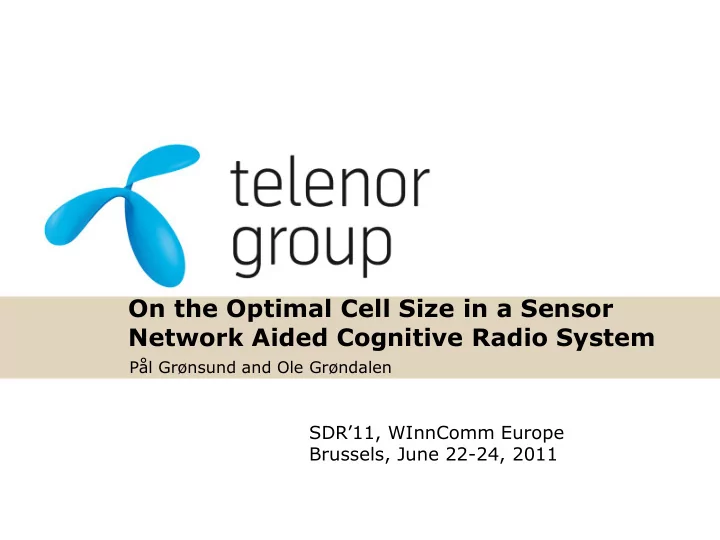

On the Optimal Cell Size in a Sensor Network Aided Cognitive Radio System Pål Grønsund and Ole Grøndalen SDR’11, WInnComm Europe Brussels, June 22-24, 2011
The SENDORA concept can be described as a "Sensor Network aided Cognitive Radio" technology Primary Network Cognitive Network queries on spectrum status Wireless Sensor Network reports on spectrum status
Performance of a sensor network aided cognitive radio system Goal: To find the optimal cell size of a sensor network aided cognitive radio system Method and tool: Simulations in the network simulator NS-2 Networks 1. Secondary Network (WiMAX with SENDORA functions, OFDMA) 2. Primary Network (WiMAX, OFDMA) 3. Wireless Sensor Network (rectangular grid of energy detecting sensors) System Details • Channels: 10 MHz channels • Duplexing: Time Division Duplex (TDD) • Frequency band: 2GHz • Modulation: BPSK, QPSK, 16-QAM, 64-QAM • Coding rates: 1/2, 2/3, 3/4
Simulation Scenario Primary System Wireless Sensor Inter-BS-dist: 2km Network*: Radius r p =1.15km 65 sensors/km 2 Secondary System Sensor radius Radius r s =? r ws =87.7m (*values from business case analysis) Primary BS Sensor Primary terminal Secondary BS Secondary Fusion terminal Centre
Key parameters for simulation scenario • Requirement: the secondary system has to operate in such a way that the maximum interference experienced by the primary network corresponds to a 0.5 dB increase of the noise-floor with 90% probability. • Sensor threshold: - 82.5dBW, detection probability ≥ 95% (from D2.1) • Sensing: Energy detection, duration 30ms, frequency 1/2 second Primary r ws user -82.5dBW sensor Parameter Primary System Secondary System Traffic CBR: 200Kbps CBR: 1Mbps Traffic direction Downlink Downlink Nodes per BS 4 4 Nodes location Random Random Nodes mobility Random waypoint, random speed 1-20 m/s No Modulation / FEC QPSK 1/2 QPSK 1/2 EIRP 13.5 dBW (for 90% area coverage) -40, - 35, … , -5 dBW
Three cases for secondary cell size were studied 1. Secondary cell size = 1/2 primary cell size (0.575 km) • 25% co-location with primary BSs 2. Secondary cell size = 2/3 primary cell size (0.767 km) • 11.1% co-location with primary BSs 3. Secondary cell size = primary cell size (1.15 km) • 100% co-location with primary BSs
Secondary system performance
Secondary system performance
Impact on primary system performance
Secondary system throughput for increasing numbers of Primary Users
In Conclusions Secondary cell size equals 1/2 and 2/3 the primary cell size performed well and achieved maximum throughput • Respectively, 25% and 11.1% of secondary BSs will not be co-located with primary BSs, leading to high costs for the establishment of new sites. • This points in the direction of smaller and less expensive BSs such as WiFi access points and femto-cells. Equal cell size for the secondary and primary systems with a cellular reuse pattern with seven frequencies is difficult to achieve • 100% BS co-location will not be achieved • Potential solutions which should be studied for future work o Cell sectorization o Relaxed requirement to allow secondary operation, and dynamic requirements when primary nodes have good connectivity o Dynamic transmit powers Questions? Pål Grønsund (Pal.Gronsund@telenor.com) http://palgronsund.com
Recommend
More recommend